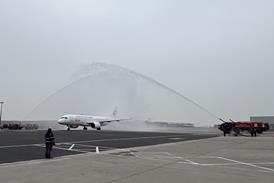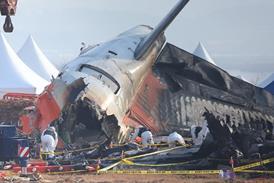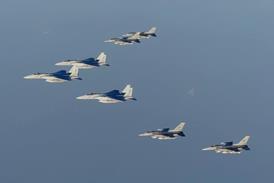Boeing and the National Research Council of Canada (NRCC, Hall 3, E41) have chosen Le Bourget to announce that they may have cracked the mystery of how ice can form in jet engine compressors despite internal temperatures being well above freezing, causing engine failure.
This phenomenon, which caused both engines in a Qatar Airlines Airbus A330 to shut down in flight near Shanghai in 2006, has been imperfectly understood, but now the Boeing-NRCC partnership has managed to reproduce the process in a test rig.
NRC president Pierre Coulombe says: "These results are an important first step in understanding what's happening at the particle level with engine icing in ice crystal conditions. Now we can begin the process of modelling the phenomenon to predict and prevent it."
Coulombe is referring to the conditions under which internal engine icing has occurred, causing engine stall or flameout. At high level, in the vicinity of thunderstorms, ice crystals are believed to form in smaller sizes than they normally do, making them less detectable to aircraft equipment like weather radar, and changing their behaviour when they are ingested into an engine.
At the NRCC's Ottawa altitude research centre, the organisation reveals, it has been able to recreate realistic high-altitude conditions, including the freezing ambient temperatures, low pressure, and the warmer conditions inside the engine.
Researchers then produced ice crystals "in the range of 70 to 200 microns in concentrations up to 15 grammes per cubic metre" and blew them into the simulated engine rig.
The result, says NRC-Boeing, was more promising than they expected: "Although the goal of the project was to create ice accretion in any quantity in a simulated engine S-duct in temperatures above 0°C, the researchers...were able to build ice formations of the size which could offset engine performance. In addition, because the tests were recorded using regular and high-speed video, they were able to determine some conditions in which accretion will and will not occur."
Boeing's aviation safety director Corky Townsend says: "This is a critical part of Boeing's multi-step plan to tackle this important industry safety issue." There have been some 14 incidents involving business jets and airliners in which the engines lost power or failed in flight. In almost all cases - including the Qatar A330 - they were successfully restarted.
This issue is critical because more high-level, long-range flights than ever are crossing oceanic areas via the tropics where high-altitude storm activity is normal, so the engine icing risk is increased, and this challenges the premises on which extended range twin engine operations rules are based.
- All the latest news, images and video from the Paris Air Show
Source: Flight Daily News




















